
Aetherone
-
Posts
21 -
Joined
-
Last visited
Posts posted by Aetherone
-
-
HA!
After a whole lot of fiddling I got the right combination of files to flash my Phison drives to F400. Turns out the various packages on usbdev.ru are incomplete - I needed "Phison_MPALL_v5.13.0C.rar" for an operational flashtool AND "firmware_ps2251-03.rar" for the correct firmware files to flash my units.
Thanks to @Xeondile for the correct settings once this lot was cobbled together.
BEFORE
AFTER
Some caution would be advised - a small number of online virus checkers flag these as potentially hostile but none of them can agree on exactly what the malware is so I'm not convinced it's a false positive given what these programs are designed to do. Still, be careful & use them offline, preferably from a disposable temporary Windows install.
-
13 hours ago, DSfuchs said:
For example, installing the JAVA package does not take 2, but rather 15 minutes.
Exactly what we see with the memory bug & I'm not the first to note it - although I don't think anyone has tried on DSM7 with these older CPUs.
Between 1 and 4GB of ram, system behaves as expected - transfers are wire speed and the UI is nice and responsive. Applications install and perform just fine, everything is ticketyboo for weeks, if not months - and with my tame application requirements, I fully expect a NAS to operate seamlessly for multiple months on end. The only reason for a reboot is a power outage longer than the UPS can sustain or a firmware upgrade.
I'm not quite sure why my 1812 saw the issue with DSM6 on 4Gb and DSM7 doesn't.
Going over the 4GB mark has some interesting side effects where the CPU is constantly maxing out with tasks that barely tickle it with <4.
This is fully apparent after a fresh boot with a fresh install with nothing more than stock apps.
The system is affected to the point where writing to it over the network is severely limited - what was a flatline 110MBps copy is now struggling to hold 40-50 with frequent pauses despite there now being more memory available to the system. Immediate fix is remove memory.
Intel did only rate the D2700 for 4Gb of ram so perhaps there's a design flaw or a deliberate performance crippling once you exceed that amount. -
7 hours ago, Xeondile said:
@Aetherone for the Chip you get the MPALL software from here: https://www.usbdev.ru/files/phison/mpall/
For me it was version 5.13.0C, so I get my one to run. Basic Settings with this small settings, see attachment
Thanks.
Had already been over usbdev.ru and pulled down pretty much every version they had. Most didn't recognise my device and the few that did couldn't cope with the Toshiba SLC NAND on it. After a bit of digging I spooled up a Windows XP machine which did a bit better but still failed to flash. -
Update: external USB stick partitions DD imaged and restored back to the stock DOM, all buttoned up and running very nicely.
While I had the lid off I tried extra ram again under DSM7 - 6GB upset it as expected, just instantly maxing a CPU core with any interaction at all. However, unlike my DSM6 experience, 4GB is running fine and dandy. System is responsive and behaves as expected - no sign at all of the CPU usage bug. Interesting.
Since DSM7.1.1 supports it, I also tested SMB multichannel - which works surprisingly well with some transfers hitting over 200MBps until the tiny ancient 120Gb SSD I've been using for testing runs out of cache 🤐. Watching htop shows SMB-MC pinning the CPU pretty hard though.
Well worth the effort to buy this old workhorse a few more years. 😎 -
7 hours ago, DSfuchs said:
That's why the downgrade to update 5 is necessary.
There we go. I missed that note further back up the thread. Good thing it's solvable with a clean HDD installation - which is probably best practice when screwing around with a NAS at this level - don't have ANY data on it you can't afford to lose!
I imagine this process is vastly more complicated if your original DOM has died. Is there any way of getting the files from a PAT or do you need a kind stranger to share their image? -
15 minutes ago, Aetherone said:
Bugger. Feeding it the "DSM_DS1813+_42218.pat" (AKA DSM v7.0.1) results in error "Incompatible upgrade file." Guess it's not fully convinced it's an 1813...
Ah HA!
Can't upgrade 12-13 Hackinology from DSM 6.2.4 to 7.0.1, it'll throw that "Incompatible upgrade file" error.
Can FRESH install 7.1.1 once you've reset the system (or fed it new drives or whatever). So glad I've got a stash of old small SATA SSDs kicking about.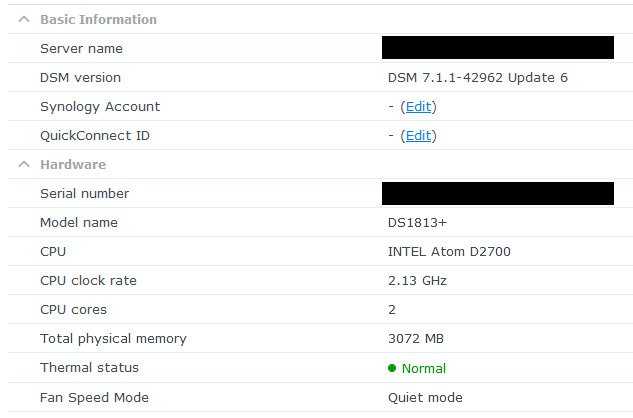
-
 1
1
-
-
49 minutes ago, Aetherone said:
Next step I guess will be to make a new backup of the USB boot image (see step 1 above) and then see if it'll upgrade to DSM 7
Bugger. Feeding it the "DSM_DS1813+_42218.pat" (AKA DSM v7.0.1) results in error "Incompatible upgrade file." Guess it's not fully convinced it's an 1813?
-
On 4/7/2024 at 12:07 AM, DSfuchs said:
I don't overwrite the files at all. I create a directory (in mc with F7) such as DSM6.2.4u7 and move (in mc F6) the files there for possible recovery.
Good plan, I did that.
In the end it was deceptively easy to persuade my DS1812+ it is really a DS1813+ instead. I didn't bother to downgrade, just installed a blank old SSD, did the file exchange and booted it up ... tada! DS1813+ reporting for duty!
To summarise for those who follow (keeping in ind I kept mine simple - one drive; last DS1812+ OS installed; no important data to lose - even if this works, your DSM version is going to be out of date so I'd be VERY cautious about exposing this to the internet).
1. Starting with a working NAS unit, log in to the SSH console and
dd if=/dev/synoboot of=/volume1/myShare/DS1812+synoboot-6.2.4u7.img
I'm not sure if you need any SynoCommunity packages to get DD. They're pretty worth it for lots of useful utilities.
We've started here because a backup image of your Synology is flat out a GOOD thing to have. Remember to put it somewhere safe (NOT on the NAS!)
2. boost your ram to 2 or 3gb. Single rank memory for these old units. Samsung seems to have a decent rep. 4Gb and above trigger the CPU usage bug for me so as nice as that much free ram is, it's at significant performance cost.
3. The really hard part - find a USB stick you can boot the machine from. It has to be something with an older chipset where the manufacturing tools have been leaked.
USB-A or small port DOM doesn't matter, making the stick F400/F400 is the important bit. For me a Toshiba flash based DOM didn't work even with the MFG tools, but a 4Gb Lexar Jumpdrive Firefly did.Strictly, you don't need the DOM if you have a working stock flash and a backup, but I'm cautious like that.
4. Once you have the stick, flash it with the DD image you used up there. I used Rufus under Windows to do mine.
5. Open the NAS, remove the stock DOM and see if it'll boot from your DIY media.
6. Assuming it booted, you now need the DS1813+ PAT file. Since my unit was updated to 6.2.4u7, I grabbed the appropriate 1813+ version "DSM_DS1813+_25556.pat".
This is where you refer back to post #35 in this thread - open "DSM_DS1813+_25556.pat" with 7zip and extract 4 files (Thanks DSfuchs for the image).
Windows didn't want to play ball for me with mounting the tiny DOM partitions so I used a Linux box instead. If you're handy with the command line or "Midnight Commander" you can do this right on the NAS (if you're brave enough, on the stock DOM no less).
With an abundance of caution, I made two folders in the second partition - 1812 files and 1813 files. Move the four relevant files to the 1812 folder for safekeeping and copy the 1813 files to the root of the partition.
That's it, job done.
Yeah, it seems too easy but it's really all there is for this.Dismount the stick, plug it into the bootable port on the NAS, slot in a blank drive and fire it up.
After a couple of nervous minutes, my unit emitted a happy beep and showed up on the network as a DS1813+ (original serial number and MAC addresses to boot). With a blank drive in it, I fed the installer the "DSM_DS1813+_25556.pat" file and let it do it's thing.
Network performance appears unchanged, all my usual swath of apps installed fine, no complaints anywhere I can see. It's just working 🤑
Next step I guess will be to make a new backup of the USB boot image (see step 1 above) and then see if it'll upgrade to DSM 7.
After that, I guess I'll give it a few weeks to be absolutely sure and then look at cloning the USB stick back to the stock DOM and buttoning the old girl up for the next 4-5-6 years.
Thanks for the advice DSfuchs!
-
36 minutes ago, DSfuchs said:
And yes, with #35 it is very easy to change the model in 10 minutes, including a restart and without screwdriver.
Thanks. Wish me luck!
Before I pull the copy trigger, any idea how the 1813 will deal with the missing two ethernet ports? ... or send it and see?
Is there any need to downgrade from U7 first? ... or send it and see?
I'm hoping that with a known good backup of the synoboot that if things don't go to plan, all I'll need to do to un-door-stop it is re-apply the flash image?
-
2 hours ago, DSfuchs said:
I hope you only have a maximum of 2GB RAM. Otherwise, the device is only suitable as a door stop

4 & 6Gb were both suffering badly with the CPU usage bug. So it's happily been running with 3 now for several weeks. Whats with 2? I put the spare 1 into it's 1513+ brother and that seems happy as a clam with 3Gb too?
Yes it counted, recognised and passed memtest with 6Gb (2+4). Pity the CPU usage was nuts and the performance severely affected.Post #35 then? Just the four files seems almost too easy?
-
Wow, it actually works.
DS1812+ booting DSM from the modified Lexar Jumpdrive 4GB, plugged into the USB2 ports on the back of the motherboard (there's no front ports on this model).
I know it's booting from the jumpdrive because the stock DOM is sitting on the desk next to me 🙃So now I humbly ask: where to?
- DS1812+
- DSM 6.2.4-25556 U7 currently installed
- dd if=/dev/synoboot of=/volume1/myShare/DS1812+synoboot-6.2.4u7.img successfully captured
- USB stick sorted and working
- One drive currently, nothing important on it - can wipe and do whatever
- DS1813+ PATS 25556 & 42218 sitting on my local drives.
Three thoughts for my afternoon
- Go back and start reading this post from the beginning yet again
- Spool up a Linux machine to make fiddling with files on the DOM easier?
- Get out a windows XP machine and see if the Phison DOM I have can be UID/VID modded there
At this stage I'm working with the assumption the Phison DOM I have here can't be modded so I'll do all the experiments with the USB stick and when it's operational, DD it again and then write that image back to the Synology DOM and keep the USB as backup incase the Synology one dies.
thanks
-
 1
1
-
2 hours ago, DSfuchs said:
You will find the items in the German marketplace ebay.de
indeed, that's where I found them. Mighty have to order 20x of them to make international shipping 16,000km worth it 😆
-
 1
1
-
-
20 hours ago, Sears said:
Update: Found an old Phison USB stick, flashed the PID/VID in a Windows XP VM
Wait, an XP VM? Is the Phison software not compatible with newer operating systems?
32 or 64 bit? I might have to dig the retro box out of the shed if this is the case?!?!
-
3 hours ago, DSfuchs said:
Like ebay item 395271211970 ... item 402060558457
I had to search ebay.de to find those numbers, not my native .com.au or the plain .com.
Looks like "Intenso" is a local brand for you based on worldwide searching. Agreed, it's questionable if the product line has stuck with flashable controllers.I found a "Micro Line" variant available via China. Thinking about grabbing a small one to see if it's flashable as that form factor would work very well with the front USB ports.
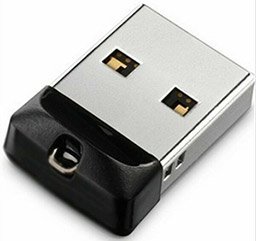 3 hours ago, yakup said:
3 hours ago, yakup said:By the way, I think I do have the same Lexar stick, I was thinking too try Lexar soft to change the VID/PID accordingly to DSFuchs instructions.
Which soft did you use to change PID VID of the Lexar please ?
ChipGenius_v4_19_0319 identified my stick as a "SMI SM3252C - ISP 100425-MI-r" with Micron flash. I found "smi_mptool_v2.03.20_v4" dated 25/02/2013 was able to recognise it and reprogram it's identity. Yes the tool came from a Russian site, so antiviral cautions are well advised.
-
 1
1
-
-
5 hours ago, yakup said:
this is difficult for new dudes like me since how can I know whether a stick memory has this type of memory or controller before buying it...
Agreed, this is possibly the biggest stumbling block here - not everyone has a drawer full of ancient old sticks. The vast majority of mine have already been written to death or given away as uselessly small years ago and their modern replacements - even the cheap giveaway ones - do not have controllers recognised by chip genius.I got lucky that my nearly 10 years old Memtest stick was suitable. It's a 4Gb Lexar Jumpdrive Firefly. The Phison based 2Gb Toshiba SLC DOM I purchased was not.
I'm hoping to do all the experimentations on the USB drive so if I kill it or corrupt the image or whatever, I can just put the Synology DOM back in and we're back up and running. Ideally I can find a programmable DOM because all-internal is neater but a USB stick will do for the R&D.-
 1
1
-
-
50 minutes ago, DSfuchs said:
There is no point in buying new USB sticks.
Damn, are we totally reliant on old USB sticks at this point? How long do we expect them to last in this situation?
Might there be something to finding a suitable DOM that can be PID/VID modded and using those? Or simply get everything working with an old USB before DD imaging it back to the stock DOM?
I have managed to turn up an pretty old Lexar Jumpdrive Firefly that's reported as having a SMI controller and I think I've managed to persuade the SMI tool to modify it.
It's very late here so I'm calling it a night, but I presume the next steps would be to flash the DD image to the USB and then remove the stock DOM and see if my 1812+ will boot from the new drive.
-
 1
1
-
-
7 hours ago, DSfuchs said:
You can use any USB stick if you have the software tool from the manufacturer to change the VID/PID. I have a drawer full of them.
That's great. I went through my collection of sticks and found the downside to buying premium Sandisk ones is the lack of generic controllers according to ChipGenius.
Hence why I thought it's be easier (and neater) to just order a DOM. Seems otherwise.
If you've got a suggestion for something currently available I can go and order from Amazon that'd be appreciated.
On the upside, I tried flashing the DD IMG from the stock DOM with Rufus. This partition layout seems promising yes?
-
 1
1
-
-
On 4/19/2023 at 4:01 PM, Lucky1234 said:
I admit that I don't want to wait until DOM is delivered to me from China, it could easily be a month. I ordered this exact DOM as it was listed in the posts here, but I thought it had a UT165 chip, but it doesn't. So I'm curious if it's possible to change the PID/VID or if Synology will accept it. I'd better start looking for the C802 USB flash drive, it's no longer sold here, so I'll have to post an ad.
Hi Lucky1234,
did you come up with a solution for your DOM here?
I'm hoping to persuade a DS1812+ that it's actually an 1813+ but have stumbled at the first hurdle - getting one of these DOMs to the correct VID/PID.My DOM appears identical to your photo - Chipgenius identifies it as a UNIGEN PHB20000IS1-ATB but I'm unable to get any of the Phison utilities to recognise it so far, despite a few hours of trawling around USBDev.ru and downloading many revisions of tools.
-
oops, double posted. Sorry.
-
On 3/12/2023 at 3:16 AM, 7up_ said:
While it is definitely a lot easier to use the external USB drive, for anyone with a corrupt Synology USB DOM or if you wish to keep things internal, any generic small 9pin USB DOM will work as replacement although it does require changing out the socket if you wish for it to mount properly and of course you do need to modify VID/PID.
Hello 7up_
I've obtained a USB DOM that appears to be identical to your photo, but I'm struggling to find a suitable utility to rewrite the VID/PID to 0400.
Have been unsuccessfully trawling around usbdev.ru for a few hours now and hoping you can point me in a suitable direction?
Chipgenius identifies the DOM as
Description: [H:]USB Mass Storage Device(UNIGEN PHB2000IS1-ATB)
Device Type: Mass Storage Device
Protocal Version: USB 2.10 <- Hint: This device can run faster when plugged to a USB3.0 port
Current Speed: High Speed
Max Current: 300mA
USB Device ID: VID = 1C79 PID = 3100
Serial Number: 40009A2DA0564870
Device Vendor: UNIGEN
Device Name: PHB2000IS1-ATB
Device Revision: 0100
Manufacturer: UNIGEN
Product Model: PHB2000IS1-ATB
Product Revision: PMAP
Controller Vendor: Phison
Controller Part-Number: PS2251-03(PS2303) - F/W 05.01.24 [2016-02-02]
Flash ID code: 98D390267615 - Toshiba TC58NVG3S0ETA00 [SLC-4K]Tools on web: http://dl.mydigit.net/special/up/phison.html
Possible Flash Part-Number
----------------------------
[1CE]TC58NVG3S0ETA00
[1CE]TC58NVG3S0FTA00
Flash ID mapping table
----------------------------
[Channel 0] [Channel 1]
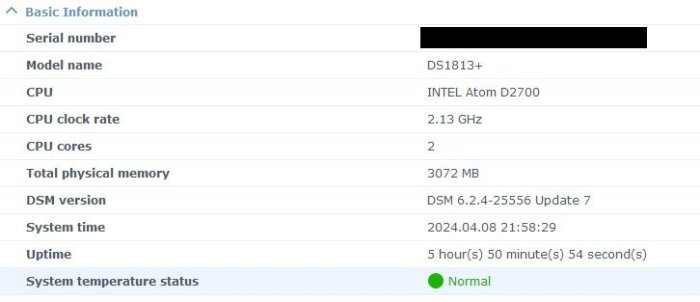
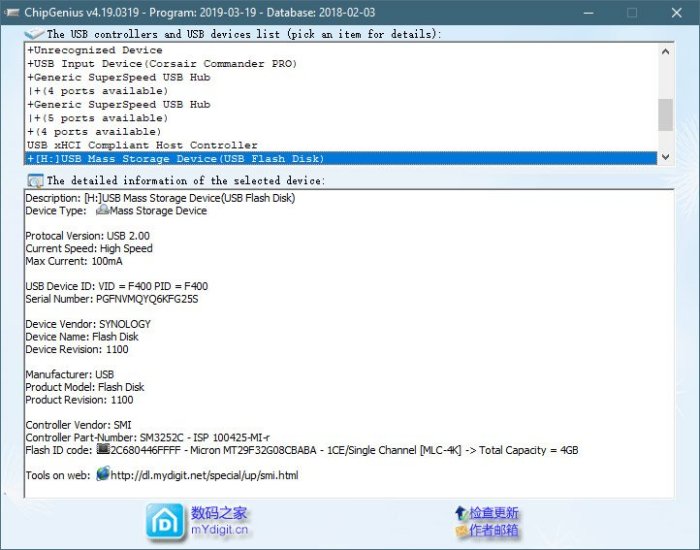

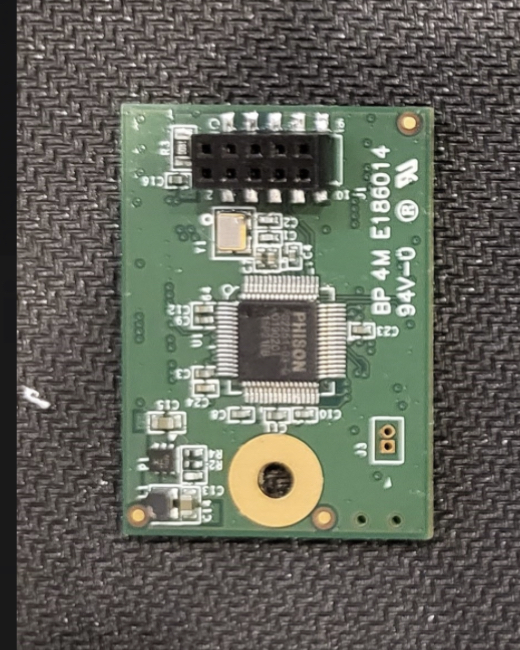
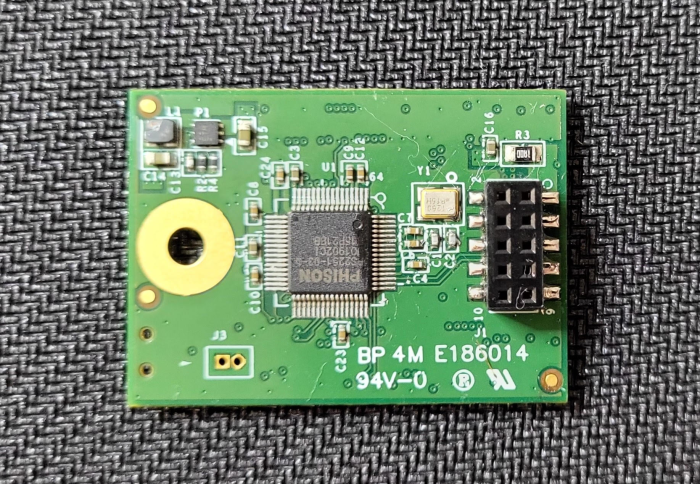
DS412+ USB flash module pinout
in Hardware Modding
Posted
HA!
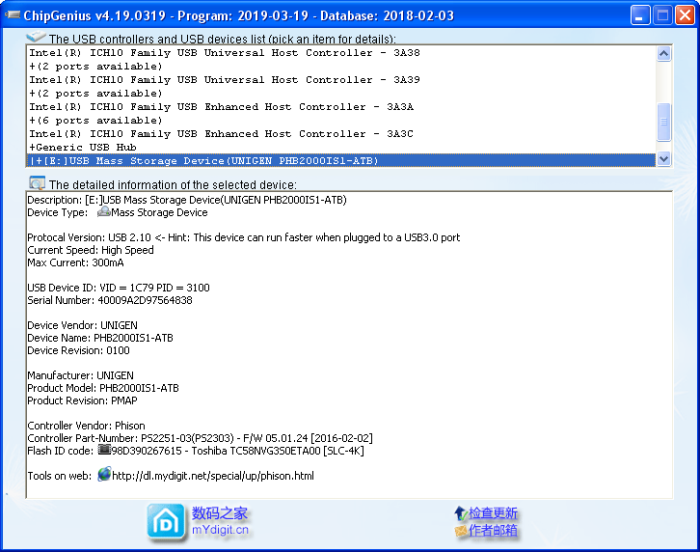
After a whole lot of fiddling I got the right combination of files to flash my Phison drives to F400. Turns out the various packages on usbdev.ru are incomplete - I needed "Phison_MPALL_v5.13.0C.rar" for an operational flashtool AND "firmware_ps2251-03.rar" for the correct firmware files to flash my units.
Thanks to @Xeondile for the correct settings once this lot was cobbled together.
BEFORE
AFTER
The settings once the firmware BIN was loaded into the folder.
As above, some caution would be advised - a small number of online virus checkers flag these as potentially hostile but none of them can agree on exactly what the malware is so I'm not convinced it's a false positive given what these programs are designed to do. Still, be careful & use them offline, preferably from a disposable temporary Windows install.